Farrier Takeaways
- Proper geometry is facilitated with trimming for hoof alignment with the load above the hoof.
- Hind-end engagement maintains front-end soundness and the hind feet are often fitted differently than the front feet.
- Hind-end engagement and soundness are diminished with faulty conformation or inadequate shoeing.
- A horse with a proper hind end and a marginal front end is preferable to the opposite.
Car manufacturers know placing the power at the rear of the vehicle allows for better balance. Nearly all race cars are rear-wheel drive so that when accelerating from a stop, the vehicle’s weight transfers to the back of the car and provides increased traction.
In many respects, the horse is the race car of the animal kingdom, a rear-view drive mammal with its hind end functioning as a piston, says Steve Kraus, head of Farrier Services and Senior Lecturer of Large Animal Surgery at Cornell University.
The certified journeyman farrier points to draft horses as proof. Heavy horses needed to stay sound so they could do draft-type work and buyers selected horses based on hocks that pointed toward each other with parallel cannon bones and a slight toe-out. This configuration places the lateral side of the hind hooves under the plumb line that is dropped from the lateral point of the hips to the ground.
“It doesn’t matter if the horse is pulling a log out of the woods, jumping a fence or roping a cow — it’s all the same,” he says. “It’s not just the draft horses, all horses need the base under their hips. And it’s a sound idea until it got perverted in the show ring.”
Despite the hind end providing the power and support that horses need to perform, it’s often overlooked. Instead, emphasis is placed on the front end. In part, basic horse handling skills encourage this. Handlers are taught to approach a horse from the front and to make eye contact to avoid spooking the horse. Walking around a strange horse and yanking its tail in the air is not advisable, but carefully moving the tail aside is necessary to observe what needs to be seen in a full evaluation, Kraus says.
“We have to see what’s going on, whether we’re selecting the horse for performance preferences or we’re going to shoe this horse,” he says. “When I started evaluating the hind end first, I received positive feedback from my clients about improved performance and balance.”
Kraus took that philosophy to Cornell University Veterinary College, especially with horses brought in for front end lameness. When he evaluated and trimmed based on the hind end, the front-end problems evaporated and the horses began carrying themselves better. Performance horses need to work off their hind ends. Riders might refer to this as self-carriage or coming through from behind and it starts with proper geometry in the hind end. Kraus explained how geometry affects trimming and shoeing at the 2020 International Hoof-Care Summit in Cincinnati, Ohio.
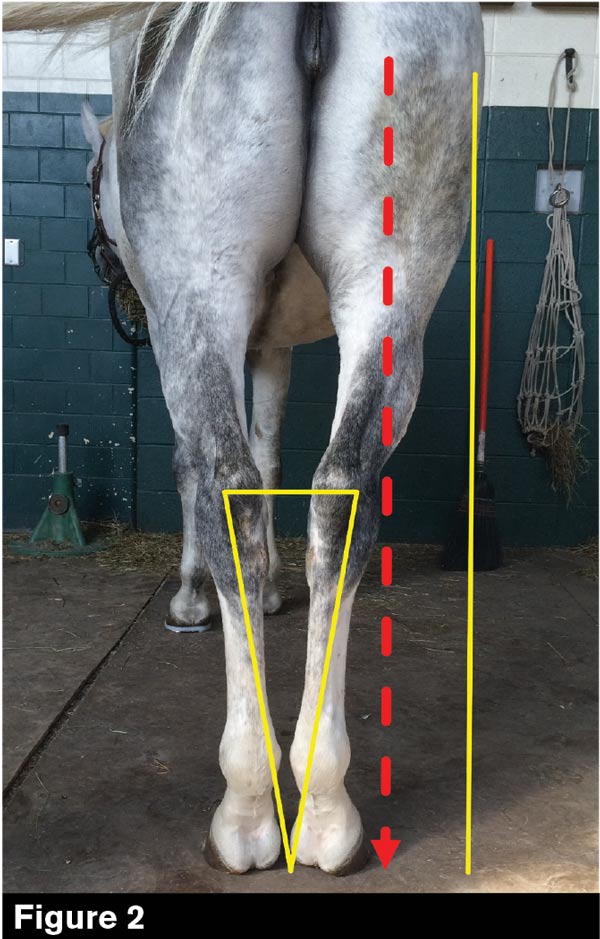
This gray Thoroughbred presents a typical base-narrow conformation with all of its mass coming down on the outside of the foot. Trimming is the foundation for correcting a faulty hind end, while shoeing is an enhancement.
The Triple Threat
Unsuitable conformation, inaccurate trimming or inadequate fitting shoes is what Kraus calls the triple threat. A horse with one or a combination of the three leads to lameness and underperformance. Understanding how the hind end works and recognizing conformational defects in the mature horse is the first step.
“In the impact phase (Figure 1 top), we see a lot of forces affecting the lower part of the limb,” Kraus explains. “As the horse moves over the foot, those forces travel up the limb. When the leg gets to the thrusting phase, these forces are going back down the limb. As the horse is in the swing phase, the forces are traveling farther up the leg as that horse is extending. As the horse completes the swing phase, the forces go farther up the backside of the leg.”
Proper geometry produces good, efficient movement that promotes soundness because the physical forces are distributed evenly. Thinking in terms of an X-, Y-, and Z-axis and using visual plumb lines from critical places on the horse’s body reveal how a horse is balanced. In a side view, the point of the hip is the Z-axis. The view from behind the horse creates the X-axis and the plumb line begins at the center of the buttocks, runs down to the hocks and finishes at the ground.
“The X-axis determines whether the horse is base-wide, or base-narrow,” he says. “The Y-axis can only be seen if you are either looking straight up the leg as if the horse is on a glass table or straight down from above. The Y-axis describes bone alignment and rotation of the leg.”
When the horse loads each hoof unevenly because of conformational defects, the forces transmitted up the leg cannot be dissipated properly. Load intensity varies based on the gait and it matters in disciplines such as reining, dressage, jumping, polo, racing and pulling/driving when the horse is being asked to move off its hind end.
“Some people talk about balance, but I think about alignment to what’s above the hoof,” he says. “It’s all about how the mass above aligns with the base.”
The Faulty Hind End (Bad Geometry)
Problems typically start at birth. Foals with poor hind end conformation should be corrected at that age and to the extent possible through corrective trimming, medial, lateral and caudal extensions when possible. Horses that are base narrow, standing under themselves, camped out behind, post legged or cow hocked all suffer from bad geometry, according to Kraus.
“Base narrow is my favorite bad geometry to hate,” he says. “The hooves are inside the plumb line, the osteoarthritis is usually in the hock and stifle, there is a medial flare on the foot, a lateral heel crush and poor hind end engagement.”
The gray Thoroughbred pictured is a classic example of base narrow conformation (Figure 2). All of the horse’s mass is coming down on the outside of the foot. Kraus compares it with a person standing with all the weight on the outside of their heel or walking on either side of a roof ridge. When the individual lifts their right leg, the left shoulder falls sideways because there’s no support. But if the stance is evened up and the mass is shifted under the core, it’s easier to stand without falling.
“It’s like wearing the heels off your shoes and you don’t replace them,” Kraus says. “Your gait changes and when you finally get a new pair you realize how much better you walk.”
Trimming is the foundation for correcting a faulty hind end, he says. Shoeing is an enhancement and he cautions against over trimming. For the Thoroughbred pictured, he trimmed the excess off the inside and achieved about 1 ½ inches between those hind legs.
“That’s all I’m going to get, it’s the way the horse wants to stand,” Kraus says. “Farriers love to get carried away, but there’s only so much every horse can handle.”
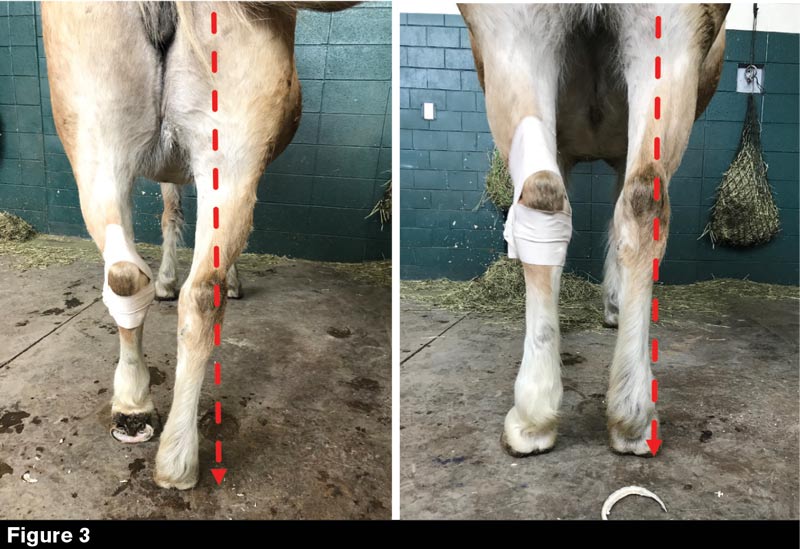
The red plumb line in the before image at left illustrates the horse standing with its weight on the outside heel. Trimming the medial flare brought the coffin bone parallel and the horse stood centered (right photo).
The Haflinger in Figure 3 is another example of base-narrow conformation. This horse had received hock injections. Radiographs revealed a medial flare and osteoarthritis. Looking at the red plumb line in the “before” image illustrates how the horse was standing with all of its weight on the outside heel. By trimming the medial flare by about 3/8 inches, it was possible to bring that coffin bone parallel and get the horse to stand centered.
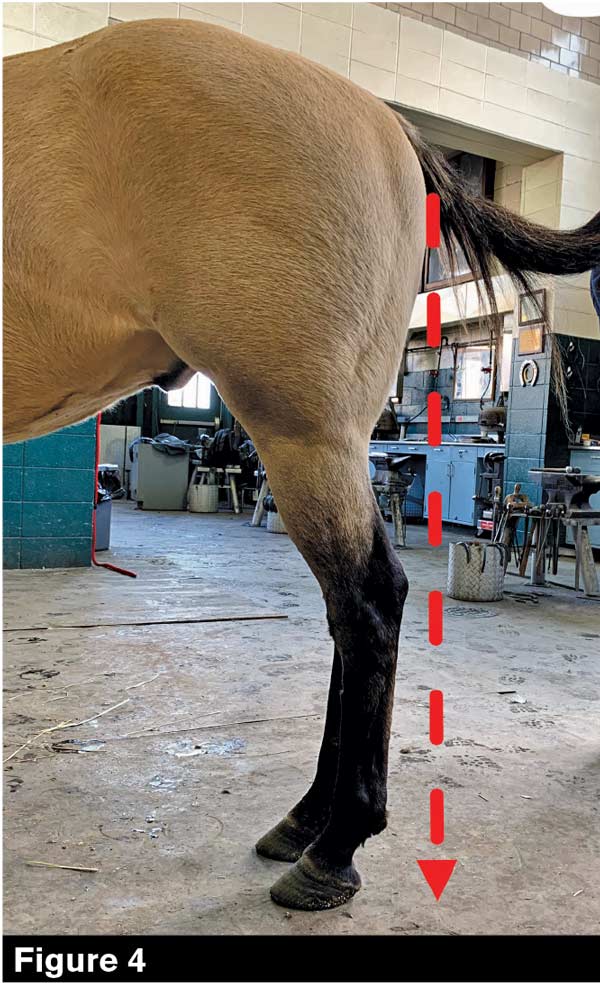
This horse’s feet are positioned in front of the plumb line; thus, it’s standing under itself. These horses typically have a negative plantar angle.
When a horse stands like this bay in Figure 4, it is said to be standing under itself. The horse’s feet are positioned in front of where a plumb line would fall. Like any of these situations, trimming is the place to start. With the heel location under the bulbs, Kraus discourages the temptation to set the shoes back and square the toes. Even though the horse is standing forward, he avoids both techniques because the horse needs its toe to propel itself forward and challenge the deep flexor tendon. These horses usually have a negative plantar angle of the coffin bone.
“Shoeing helps to some degree on this horse, but on mature horses, we’re not going to change them that much,” Kraus says. “We’re able to move these lines a little bit better, though, and that’s all we can do sometimes. We have to pay attention to how we fit the shoes. An extended heel can be helpful on horses that stand under or sometimes going up to a longer, bigger shoe helps too.”
Another common fault is what’s called “windswept.” In these horses, the left side alignment is fairly normal, but the right side isn’t (Figure 5). For reasons unknown, the straight hock is usually on the right side. This defect causes the horse to track unevenly, but more importantly, this horse will have weak dressage scores or poor turning ability when working to the right.
“The windswept horse needs each foot shod individually,” he says. “Often a wider lateral branch shoe of the straight hock side and rolling the toe medially will help. The opposite foot is shod normally.”
Horses that are camped out or strung out behind are also problematic. A plumb line on the black horse in Figure 6 reveals that the hocks are behind the plumb line, so the horse leaves its hind end behind as it moves forward. Improper muscle development of the hind end and gluteal and back strains are common in these horses. They will struggle to collect, lack impulsion and move in a strung-out fashion.
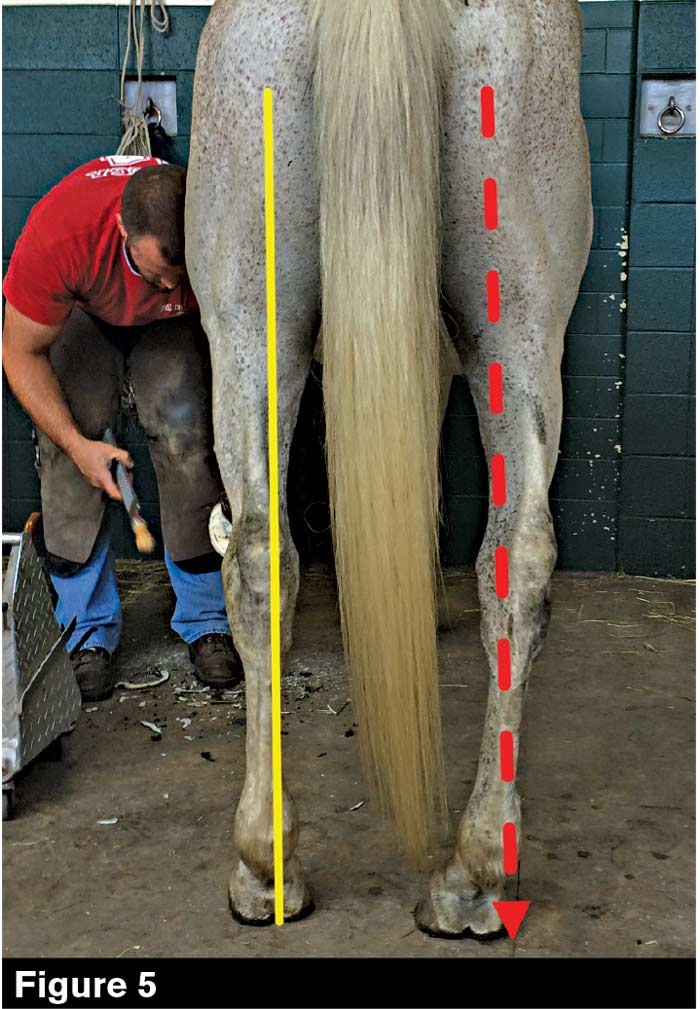
This “windswept” horse has a fairly normal alignment on the left side, while the right is not. A wider lateral branch shoe on the straight hock side and rolling the toe medially will help. The opposite foot is shod normally.
“The camped-out or strung-out horse may be helped with some artificial heel elevation, after a proper geometric trim,” Kraus says. “Wedge pads, bar wedges and even wedge shoes are used to move the base forward. If a wedge pad is used, usually a longer shoe should be used because we always want to support the heels.”
Improving posture is always the goal more than making a horse pretty. Although Kraus doesn’t often use wedges on hind feet, in some situations wedges help move the center of balance forward so the horse stands in a more normal posture. With a wedge, the shoe might need to be a size larger or will need an extended heel.
“Don’t put the same size shoe on a wedge without getting some shoe length behind the foot because you’re going to create a fulcrum and the horse is still going to fall off the back of the fulcrum,” he says.
Upright hind feet with joints that are too straight and legs that are forward of the buttocks are called post legs. The stiff structure cannot absorb shock and these horses often suffer from ringbone and chip fractures in the hock and stifle.
“Every power thrust is like a pogo stick,” Kraus says. “They injure themselves very easily because these bones are just getting jammed hard on every stride.”
It’s far less common to see a post legged horse compared with the others described, according to Kraus. Shoes with rocker toes are likely the only option for helping the horse as they add flexion by creating a little more motion. Synthetic shock-absorbing packing might also help reduce concussion.
“Physical forces can only be managed with the right geometry to handle them,” Kraus says. “Proper geometry is facilitated with trimming the hoof for alignment with the load above. I see so many horses shod with a hind shoe that is fit tight and short and just like a front foot and it just doesn’t work, you can’t shoe hind feet like front feet.”
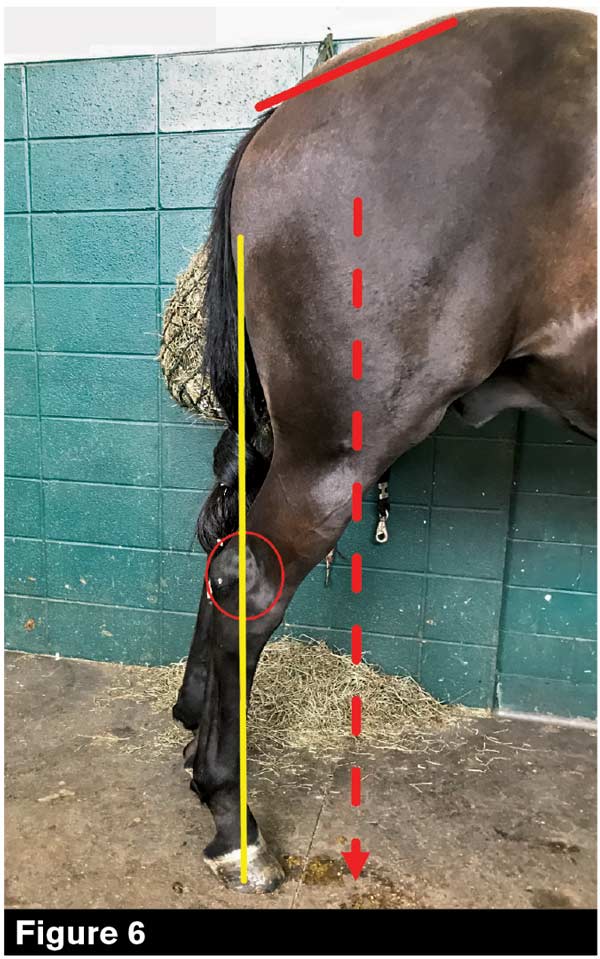
A horse that is camped out or strung out behind has its hocks behind the plumb line, resulting in it leaving its hind end behind as it moves forward. A proper geometric trim and artificial heel elevation such as wedge pads, bar wedges and wedge shoes might help these horses.
Injuries Caused by “Bad Physics”
Poor geometry in the hind end does more than handicap a horse for its task, it increases the risk of injuries and pathologies. Common ailments caused by bad physics of the hind end include a negative plantar angle; ringbone; degenerative suspensory ligament disease; curb, which is a ruptured plantar ligament and osteoarthritis is pervasive up and down in the joints.
“Gluteal back strains are also common but aren’t something a lot of people think about that a farrier can help with,” he says. “It is commonly thought that because most front-end lameness is below the fetlock, the farrier has more influence there. However, most hind-end lameness is from the hocks up, and it’s believed that the farrier has little influence. I disagree. If the farrier understands the geometry of the hind end, they can prevent or manage hind-end lameness.”
Subtle signs are as important as a visible lameness. Flexion is one test Kraus uses. On a balanced horse, it may take a second or two to stretch the hind leg to get into shoeing position, which is not unlike a person getting out of the bed in the morning and needing a moment to get going. However, a lack of flexion is an indication something is going on.
Flinching when the shoes are hammered on, especially in cold weather, is another signal of soreness, especially in horses that are base narrow. The wincing illustrates that arthritis is present and the shock of nailing on a shoe is traveling up the inside of the leg causing pain.
LEARN MORE
Gain more insight from Steve Kraus by:
- Listening to the American Farriers Journal Podcast in which he discusses his decades in farriery, his role in educating farriers and vet students and what makes an idea an innovation.
- Reading “Chalklines Help Determine Trim,” in which Kraus discusses how the golden ratio helps him teach students how to develop their eye for trimming.
- Watching “Applying the Golden Ratio to Your Footcare,” in which Kraus demonstrates how he applies the golden ratio to his evaluation of a horse.”
Access this content by visiting
americanfarriers.com/0520
“Once we get its leg up, it feels like a horse is pulling our knees,” he says. “The horse is tight and there’s something going on. Maybe we can help it. Wear patterns on the feet, bruising on the foot and hoof distortion are nothing new, but all signs that the hoof capsules are migrating one way or the other.”
Trimming is the foundation for long-lasting soundness and performance. A geometric trim is one where the heel location on the foot is at the widest, highest part of the frog and does not run forward or get stacked up. Nor should the toes be dubbed off or shoes set back.
“Horses need their toes to propel forward and they need their heels to support the mass above the hoof,” he says. “Jacked up heels may relieve strain on the deep flexor tendon but cause injuries on the superficial flexor tendon and suspensory ligament, which are very common.”
However, once a farrier moves past trimming to shoeing, Kraus emphasizes that the hind end cannot be shod the same as the front feet.
“The hind end of the horse is where the power comes from,” Kraus concludes. “If the geometry is good (Figure 7), the physics will work well and not cause damage. We farriers should assess the hind end before applying shoes and recognize how to provide help.”
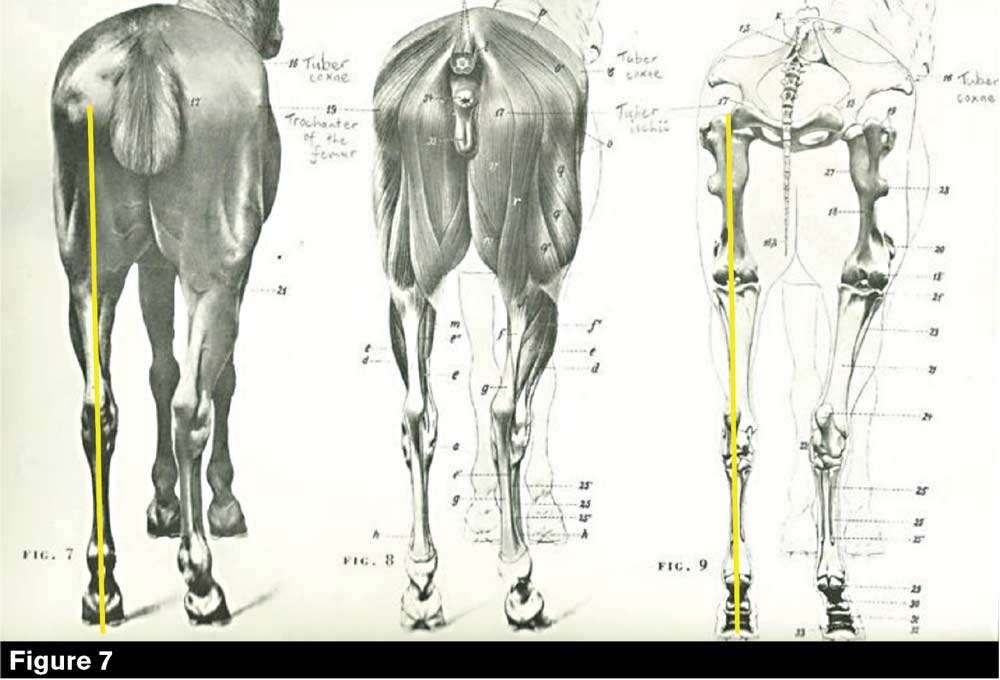
Farriers should asses the hind end before applying shoes and recognize how to help the horse. When the geometry of the trim is good, physics will follow.

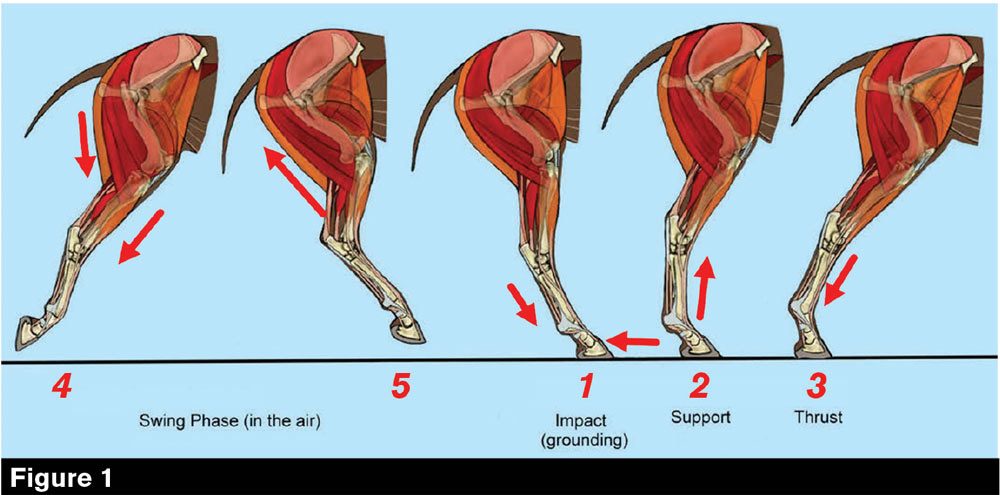







Post a comment
Report Abusive Comment